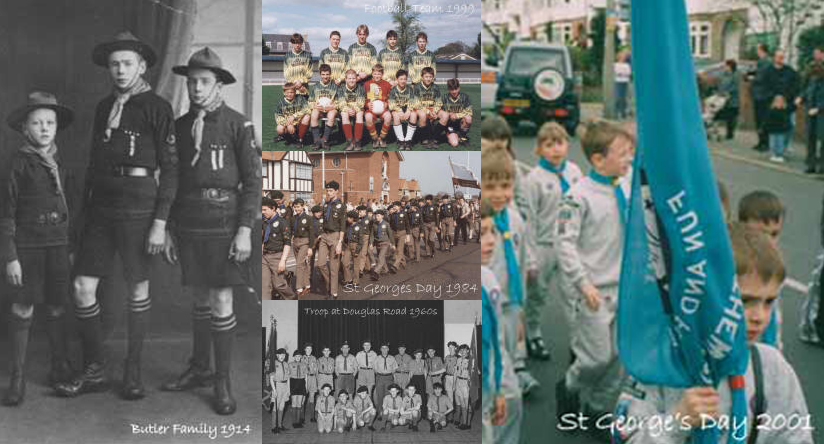A Long History
The original name of Tolworth was Taleorde and was mentioned in the Domesday Book. Its spelling gradually changed to Talworth and remained like that until the 1880s when it became Tolworth.

Early Years
By 1908 the hamlet of Tolworth was beginning to change. The population growth had started to accelerate due to the development of the brickfields and the building of Tolworth Sewage Farm, both in Red Lion Lane. It meant that the area had a proper drainage system and the District, therefore, was ready for development.

The London to Southampton railway ran through Surbiton; St Matthew’s Church had been built for a congregation of 800; St Matthew’s School was on the corner of Ewell Road and Broomfield Road; the Isolation hospital in Red Lion Lane had been completed and trams started running from the Red Lion pub to Surbiton and Kingston. Tolworth was therefore linked to these towns by efficient public transport.
In 1908 the area was still being used for agricultural and dairy farming by the seven farmers of this hamlet. The Pyne Road Mission Hall was used as a centre for the social life of the area and the Douglas Road Parish Hall opened for use by the many clubs and societies affiliated to the church. It also became the meeting place for the 1st Tolworth Scouts.
With so much countryside on the doorstep many families would ramble over the fields to Chessington and the Bonesgate and pick blackberries in season. It was in 1908 that the Curate of St Matthew’s, the Reverend Reggie Bullock, also took young members of the Lads Club on such a journey. These youngsters were to become the first members of the 1st Tolworth Troop whose pioneering journey we commemorate today.
By the end of 1908 St Matthew’s School was overcrowded and the Surrey County Council built Tolworth Infants School and the adjacent Boys School on a site between Douglas Road and Red Lion Lane.
Over the years estates and farms were broken up into plots of land for housing, particularly in Ewell Road, Ditton Road and Ellerton Road.
In 1915 our first Cub Pack was registered and in 1918 Reggie left the flourishing parish. He was followed by the Reverend J Clifford Banham who became Vicar and the Scoutmaster. He was also talented in his work with young people.
Four years after the end of World War One the British Legion opened its building in Hollyfield Road for servicemen who had fought in the War.
In 1927 the Kingston By-Pass opened which attracted light industry and building contractors to Tolworth. Six and a half miles of new residential roads, containing 2000 houses, were built including Hamilton Avenue, Princes Avenue and the Sunray Estate. 57 shops, the nucleus of The Broadway, were built on the pastures of Tolworth Lodge Farm after it was sold for development. About this time trams were replaced by trolley buses.
Tolworth Central School, built on the site of Fullers Farm, opened in 1932 for boys and girls and six years later Tolworth was linked by a branch railway line to Wimbledon and Waterloo.
After the War the blackout thankfully ended, street parties were held but rationing continued.
By 1947 the continuous development of Tolworth was halted by the Town and Country Planning Act which established the Green Belt around London.
In the following years the Kingston By-Pass became increasingly important due to the use of the motor car, the development of industrial estates with new factories and the growing importance of London Airport.
The 22 storey Tolworth Tower was built on the site of the Odeon cinema at the Toby Jug roundabout and completed in 1963. Fine Fare supermarket, the largest in the country, opened at ground level. Government departments used the Tower for its offices. Today, the Tower’s roof supports the wireless masts used for our local Radio Jackie whose offices are in the old Branch Post Office building in the Broadway. Charrington Bowl, with 32 lanes, also opened in the same year.
An Act of Parliament set up the Greater London Council in 1965 and Tolworth changed from being a part of the Borough of Surbiton to joining with Kingston to form the current London Borough of Kingston Upon Thames.
In 1966 the Mission Hall in Pyne Road was donated to the Group by the trustees of 1st Surbiton Park (Spark’s) Scout Group in whose memory our current building is named. Due to age and being declared unsafe, it was demolished and rebuilt in 1992. A fund raising initiative called “Raise the Roof” enabled much needed funds to be obtained by various methods.
During the past Century Tolworth has continually strived to improve itself, to modernise, and for the residents to increase their standard of living.
1st Tolworth (St. Matthews) Scout Group has survived over 100 years due to the enthusiasm and dedication of many adult leaders. We can all be proud of their contribution in helping the youth of our neighbourhood to become better adult citizens in accordance with the Scout Law and Promise. Many supporters, parents and Old Scouts over the years have given valuable service to the Group.
Without doubt, one and all will wish that 1st Tolworth continues to flourish for many more years to come.
May God bless us all
Graham Warnes
Group Vice President